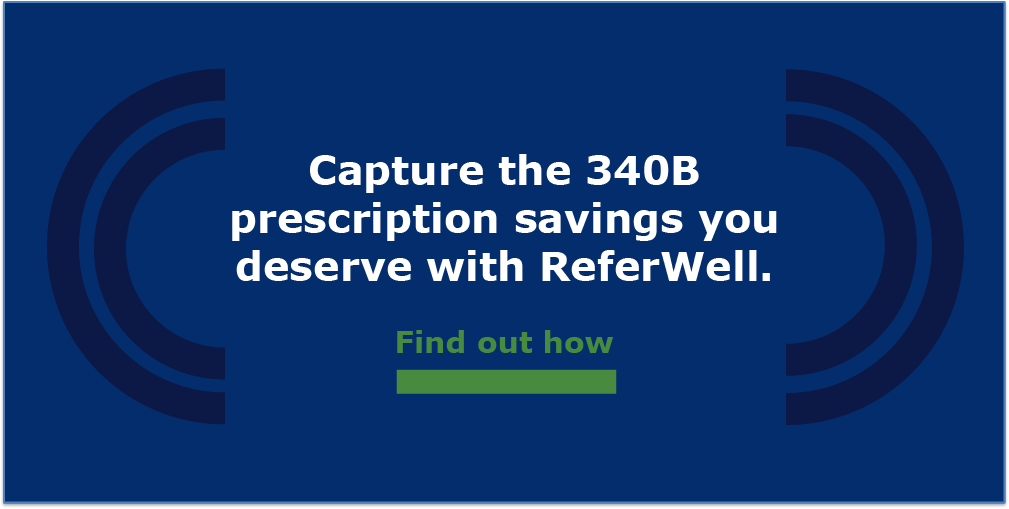How FQHCs can Capture 340B Prescriptions from Specialist Referrals

Federally Qualified Health Centers (FQHCs) are crucial safety net providers of outpatient care for underserved populations. As defined by the Health Resources and Services Administration, FQHCs are non-profit organizations that:
- Provide primary and preventive health care as is typically provided in an outpatient setting
- Serve underinsured populations and/or medically-underserved areas
- Offer care on a sliding fee scale based on patients’ ability to pay
- Receive government funding through Section 330 of the Public Health Service Act or other grants
- Have a governing board comprising mostly patients of the FQHC, among other requirements
What is the 340B Program?
One of the ways that FQHCs increase revenue and recoup savings so they can provide free and low-cost patient care is through the 340B Drug Pricing Program.
The U.S. government started the 340B Program in 1992 to allow qualifying hospitals and health centers — referred to as covered entities — to purchase outpatient prescription drugs for their patients at substantial discounts. These discounts range from 20% to as high as 50 %. FQHCs may be reimbursed at the full rate if the prescription is filled at a designated contract pharmacy.
Sounds like a win-win for health centers and their patients, right?
This process gets tricky when the health center’s physicians refer patients for specialty care and the FQHC is unable to compliantly close the loop on patient care.
For example:
When the FQHC refers a 340B patient to a specialist, the health center is entitled to the full reimbursement rate on any prescription that specialist writes — assuming the health center can prove ownership of the patient’s care.
Many FQHCs lack a good way to prove ownership and capture prescriptions from referrals, causing them to miss out on significant savings. In fact, the average 340B capture rate is just 2% for prescriptions written by a specialist outside a covered entity. In other words, FQHCs lose 98% of these revenue-generating opportunities.
How do you capture more 340B prescriptions from referrals?
It’s not the FQHC’s fault that they’re missing these savings.
One major challenge is that health centers lack visibility into when and where their PCPs are directing patients for specialty care. Without a clear understanding, it is nearly impossible to capture savings from prescriptions those specialists write.
That’s why software that allows FQHCs to schedule specialist appointments right at the point of care and track that they happened is so useful. By booking at the point of care, FQHCs document where the patient will receive specialty care and immediately bump up patient show rate for specialty care to 74% for Medicaid patients (compared to the current 34% average show rate).
A second barrier is that FQHCs lack a system to direct patients to contract pharmacies where health centers have arrangements to be reimbursed in full for prescriptions. Many health centers cannot bear the cost or burden of having an internal pharmacy, so they contract with external pharmacies to dispense the drugs that the health center has purchased at a discount. But when patients fill their prescriptions elsewhere, health centers do not benefit from the savings.
Tech-enabled solutions can help PCPs determine the most convenient contract pharmacy for the patient and send them there for qualifying prescriptions, simultaneously improving the patient experience and setting up the FQHC for higher reimbursements on 340B drugs.
A third difficulty is that specialists need an efficient way to close the loop with FQHCs. Without proper documentation sent back to PCP, the health center can’t capture the prescription savings.
The right software enables medical records to be shared between the PCP and the specialist, creating an audit trail for the covered entity to claim 340B savings. ReferWell not only provides this type of cloud-based platform, but also offers an Operations team to follow up with specialists when necessary and ensure that they close the loop.
With automatic clinical data capture from the specialist visit, it’s easy for FQHCs to meet 340B program requirements, expand savings opportunities and reverse denied claims without additional paperwork or labor. That means better care coordination, more satisfied patients and increased revenue for FQHCs to continue serving their communities.
Written by Jackie Simon
Jackie is our specialist on all items pertaining to marketing. She ensures that we produce superior content, processes and experiences that engage and educate people about ReferWell. With more than 15 years of experience, Jackie keeps people informed about ReferWell happenings, which contributes broadly to ReferWell’s success.

 © COPYRIGHT REFERWELL
© COPYRIGHT REFERWELL 